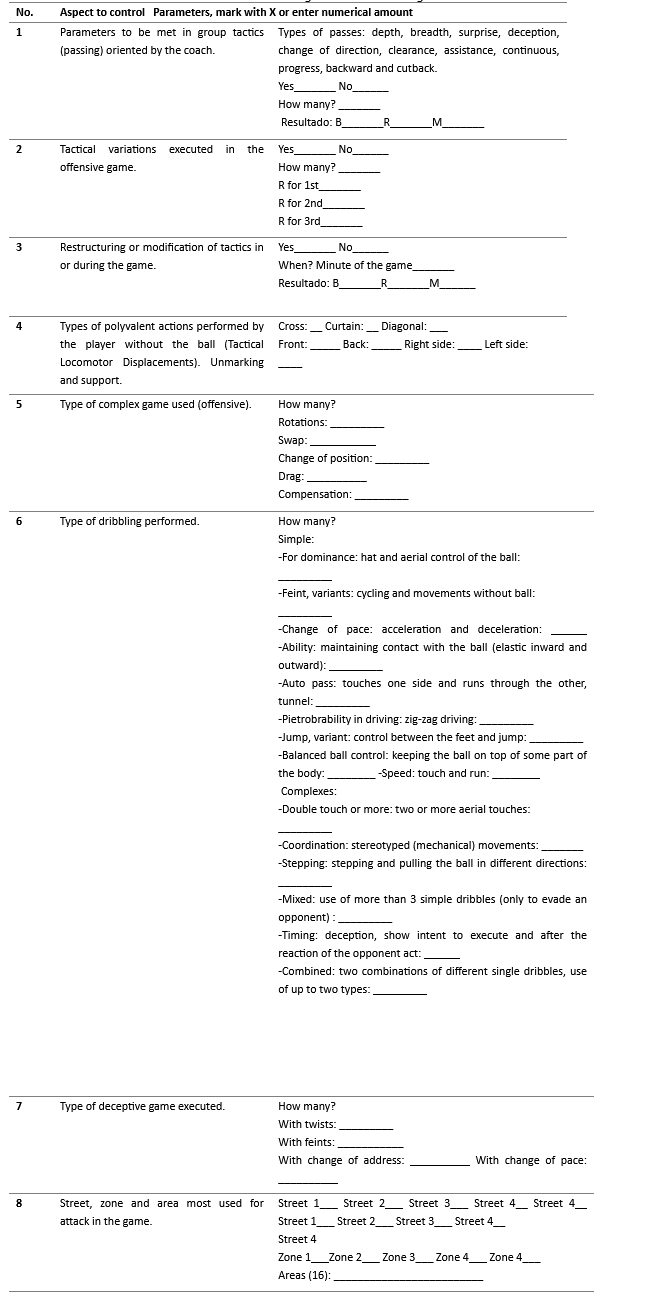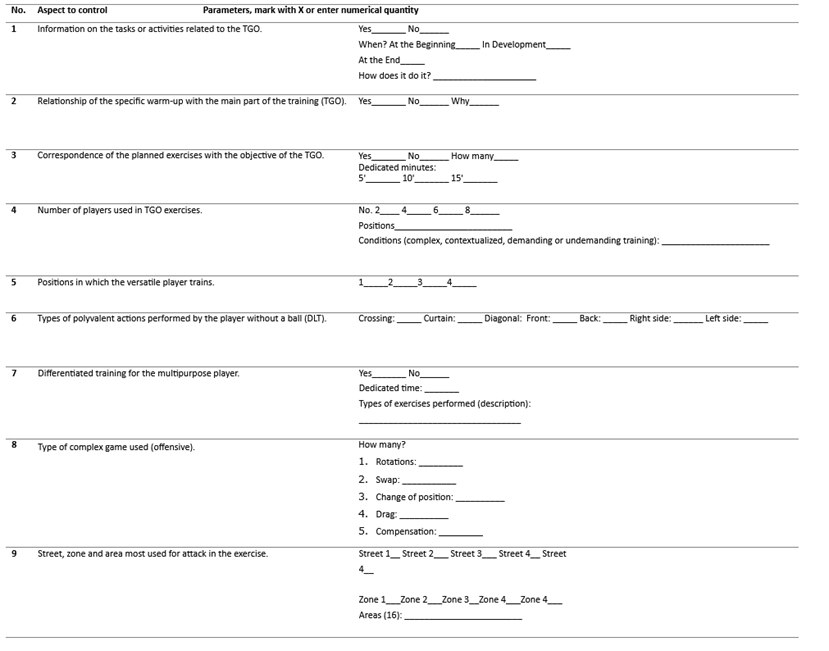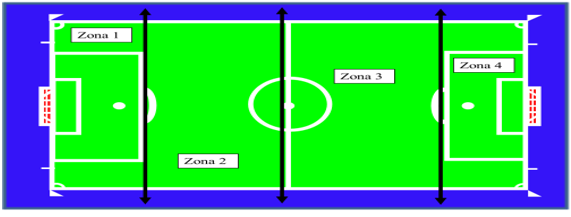Meu SciELO
Serviços Personalizados
Journal
Artigo
Indicadores
-
 Citado por SciELO
Citado por SciELO
Links relacionados
-
 Similares em
SciELO
Similares em
SciELO
Compartilhar
Podium. Revista de Ciencia y Tecnología en la Cultura Física
versão On-line ISSN 1996-2452
Rev Podium vol.17 no.1 Pinar del Río jan.-abr. 2022 Epub 11-Abr-2022
Original article
Guide for the observational control of offensive group tactics in soccer
1Universidad de Camagüey, Facultad Cultura Física "Manuel Piti Fajardo". Camagüey, Cuba.
2Universidad de Las Tunas. Facultad de Cultura Física. Las Tunas, Cuba.
Observational control models are used to carry out studies of opponents, allowing the tactical strategist to detect and plan a group of actions according to the weaknesses and strengths of the opponents. The objective of this research was to make a guide for observational control on offensive group tactics in soccer for analysts and coaches of this sport. Methods such as experiential experience, observation, documentary review and reflective critical opinion workshops were used. A non-probabilistic discretional sampling was used where the arguments were elaborated by 20 members of the International Group for the Preparation, Rehabilitation, Recreation and Research and Improvement in Soccer disciplines; these professors, analysts and soccer coaches belong to the Universities of Camagüey and Las Tunas. Two observation guides were made for the games and another one for the soccer training, both in function of the observational control of the offensive group tactics. It was verified the application of the elaborated observational guides that allow knowing the depth with which the soccer players manage to form and externalize the tactical habits during the game.
Keywords: Observational control; Sports intelligence; Observation guide; Training; Soccer games.
INTRODUCTION
Nowadays, modern soccer is so competitive, so it faces multiple challenges according to the nature and dynamics of the game, motivates researchers to identify patterns and performance indicators (Dufour et al., 2017), which can provide coaches with useful information on individual and collective analysis of their players Gudmundsson and Horton, 2017). In this sense, Caicedo and Calderón (2020) state that the quantification of offensive tactical actions are basic units within the analysis of data quality.
The quantification of offensive tactical actions, the frequency with which they are executed individually and as a group, as well as the beginning and end, the identification within areas of the field, both own and opposing, are basic units within the analysis of the quality of the data. This is based on a refined observation analysis, where a dynamic ecological perspective is developed (Lozano et al., 2016) that allows the existing relationship between actions and tactical situations framed in perception, identification, decision and execution.
Correspondingly, in the analysis of observational methodology there are different instruments that aim to collect and provide information on different variables in the sporting aspect (Maneiro et al., 2017; Fabra et al., 2018; Nadal et al., 2018). Likewise, and according to Anguera et al. (2018), the importance of observation in the sports field, from a procedural aspect, lies in the fact that it is the only scientific methodology that allows the collection of data directly from participants in training and competition, from the capture of perceptible information (p. 17).
The oldest method (observation) has been used to obtain better analyses of soccer games: Amatria, Maneiro and Anguera, (2019) ; Amatria et al. (2019); Clemente, et al. (2019); Machado et al. (2019); García-Angulo et al., (2020).
Consequently, Caicedo, Vera & Ortega (2018) state that "...the dynamics of the game needs an instrument that allows synthesizing and interpreting the ongoing interactions" (p. 12). Which allows understanding the how and why in sports performance, which admits detecting functional behaviors and patterns of the offensive group, according to the complexity of more functional actions.
Determining these aspects in the players allows the inclusion of entropies, which should be consolidated theoretically, mentally and practically in training (Martín et al., 2015a, p. 9). Regarding the types of controls, (Martín et al., 2015b) refer that they allow knowing the depth with which the players have managed to form and externalize the tactical habits, which cannot be rigid but flexible, must be rewarded with creativity and susceptible to constant improvisation (...) that is where the player has to be able to overcome the personal duel through a dribble, a legal charge, deceptive play or a Locomotor Tactical Displacement (DLT in Spanish).
In sports, artificial intelligence and sports intelligence are becoming important topics for recreational, school, high performance and even academic and scientific purposes. In this regard, Albarrán (2020) stated that social circles discuss and promote forums aimed at making virtual environments mediated by technology, in this case, sports, more efficient.
In these categories, artificial intelligence and sports intelligence, the author refers to the meaning of sports intelligence, but not before differentiating it from artificial intelligence, where both are tools that favor sport.
For the above mentioned, Albarrán (2020) highlights that "Artificial intelligence (deep learning) as part of a broader set of machine learning methods, based on the assimilation of data representations, can be used for countless things, such as classification or prediction". As well as, such methods and techniques solve to a great extent the problems and cases that arise around sport, making a real revolution of sports service, in areas of sports performance analysis with application in sports biomechanics (Albarrán, 2020) "such as Expert Fuzzy Systems, Multilevel Neural Networks or Evolutionary Computing". But, sports intelligence defined by the authors: It is the discipline of Management Sciences that allows obtaining, in a systematic and organized way, significant information about the characterization of the external environment and the internal conditions of a sports team, which allows the development of strategies that facilitate the execution of a technical-tactical action that contributes to obtain in an efficient and effective way, competitive advantages in their sport (Martín et al., 2014, p.12).
The author refers that, contrary to artificial intelligence, sports intelligence is primarily focused on sports performance, high performance and sports success at a very high competitive level.
In professional soccer, today almost all teams employ tracking technology to monitor performance during training and matches. In recent years, there has been a rapid increase in both the quality and quantity of data collected in soccer (Goes et al., 2019). There are specific observation instruments in sport that have served as a reference for experts in the field. They consist of a series of criteria with their respective categories and they must be exhaustive and mutually exclusive, as defined by Anguera (2015):
Exhaustiveness: the set of observation units fully covers the conceptual scope delimited by the object of study.
Mutual exclusivity: each of the units of observation designates a class of behavior which conceptual and operational meaning cannot be confused in any aspect with that of others.
In this case, models for the control of individual and group tactics are an important tool for diagnosis (Sanpedro, 1999). Although there are models for the observational control of offensive tactics, they do not fit the particularities of the research. The study carried out allowed the determination of the existing cognitive deficiencies and the lack of a guide for the observational control of offensive tactics during training and the game. Based on the aforementioned, the objective of this study is to create guides for observational control of offensive tactics in soccer for soccer analysts and coaches.
MATERIALS AND METHODS
In order to carry out the research, a qualitative observational study was carried out, where different methods were used, such as theoretical, experiential, documentary review and reflective critical opinion workshops; in the practical order, the unstructured interview was used as a living source of personal communication.
Material and sample
A non-probabilistic discretionary sampling was used where the arguments were elaborated by 20 members of the International Group for the preparation, rehabilitation, recreation and research and improvement in soccer disciplines (GIPR²ISDFUT); these professors, analysts and soccer coaches belong to the Universities of Camagüey and Las Tunas.
RESULTS AND DISCUSSION
Observational control of the offensive group tactic
The observation guide on offensive tactics was constructed to be applied in the competitive game activity. Group tactics are linked to groups of players, which depending on their position, can be homogeneous (players of the same position) or heterogeneous (players of different positions). The table is composed of 8 aspects, seven of them linked to tactical actions and one to the area in which it occurs. The aspects to be controlled, 6 and 7, constitute research results published in previous articles by members of the GIPR²ISDFUT, while the other aspects were suggested to be incorporated in the reflective critical opinion workshops. This guide allowed studies of sports intelligence during the team's own game, the correspondence between what is oriented and executed by the soccer players was determined in order to make the necessary corrections (theoretical-mental-practical).
General data: Date: ____ Place: ___ Team: ____ Category: ____ Province (state):
________ Country: _________
Soccer player (name and surname): _______________________________________ By means of the observation guide, the objective is to control the offensive group tactical activity of the players who participate in the offensive tactical blocks (midfielders and forwards) during the game (Tabe 1).
Objective: to determine the execution of offensive group tactical actions in the game of soccer.
Observational control of the offensive group tactic
The second observation guide on offensive tactics is made to be applied in the training activity. Group tactics on the actions of homogeneous or heterogeneous players during simulated training is a key to materialize in the competition, however, these should not only be trained practically, but also theoretically and mentally. This table is composed of 9 aspects, 8 of them linked to tactical actions and one to the area in which they occur. The aspects to control from 1 to 8, constitute research results published in previous articles by members of the GIPR²ISDFUT, which are referenced in the bibliography, were deepened through the explanations described, on aspects 2 and 3 were suggested to incorporate. This guide allows for sports intelligence studies, both on the opponent to be faced and on the team itself; this diagnosis made it possible to carry out a better preparation during the training matches, first on the defensive to counteract the offensive of the opponent and then to potentiate the present one.
General data: Date: ____ Place: ___ Team: ____ Category: ____ Province (state):______Country:______ Player (first and last names): _______________________________________________
By means of this observation guide, the objective is to control the offensive group tactical activity (TGO) executed by the players during training (Tabla 2).
Objective: to determine the execution of offensive group tactics actions in soccer training.
Structure for the positional location of the player on the soccer field according to the areas (lanes and zones)
The abstract subdivisions with imaginary lines on the soccer field illustrated below were support tools for both observation guides (these are linked to aspects number 8 and 9 of the tables), since the offensive tactical action occurs in a certain place on the field by dividing the field into lanes and zones, which together make up 16 areas, which make it possible to pinpoint the location in which it has occurred, a relevant aspect, since not all areas have the same offensive danger. This favors the execution of an accurate diagnosis by the observer who records the action of the offensive group tactic (Figure 1, Figure 2, Figure 3).
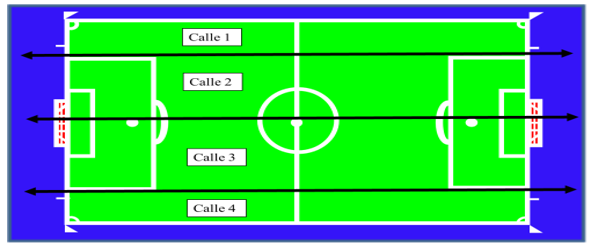
Reading, always from left to right
Fig. 1 - Soccer field. The lanes (4), these in turn, could contain smaller microlines or micro-passages
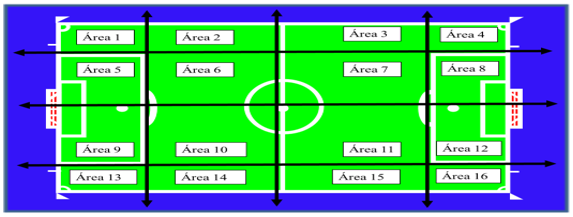
Consecutive reading, always from left to right
Fig. 3 - Soccer Field. The areas (maximum safety areas 5 and 9; safety areas 1 and 13; foundation areas 2, 6, 10 and 14; construction areas 3, 7, 11 and 15; completion areas 4 and 16; touchdown areas 8 and 12)
The beginning of the training period favors the observation of the tactical, technical, physical and psychological characteristics of the players, thus orienting the planning to specific aspects, inherent to the functionality of the game (Bettega, Galatti, Schmitz, Tozetto, Longarela, and Scaglia, 2016). The observational control of the offensive group tactics on the attacking blocks during the game is determinant, Martín (2018) exposes that, "...knowing precisely which are the planned and improvised tactical drawings, used more frequently, (...) must be in correspondence with the integral profile of the players available" (p.10).
In this sense, Anguera et al., (2018), made a practical tool for the collection of clear and systematic information that allows defining parameters for their respective analysis. This instrument was designed as an observation system, which allows to analyze in detail how the offensive tactical actions were executed.
As a starting point for the analysis in this article, related to models for the observational control of offensive group tactics in soccer, Martín et al., (2014) describe the logical methodological structuring of a new school for Cuban soccer, where the starting point is the ordered and coherent classification of the component elements of tactics in soccer, which still does not meet the expectations expected by the current study. Consequently, another model is made that allows the control of the game system (Martín et al., 2015c, p. 7) composed of the game model scheme, tactical drawings and individualities. In this sense, it is good to highlight its use during the 2016-2017 season in the Cuban National Championship, an aspect that consolidates its generalization in the country. It is convenient to specify that it is not foreseen the control, neither of the game models, nor of the successive aspects that compose it, aspects to which a solution is given from the group point of view in the mentioned article.
Consequently, in 2015, a more comprehensive study is made that reaches the magnitude of everything concerning the soccer game, where Martín, Montero and Blanca (2016) addressed the reading of the match and the soccer game and steps of progress were achieved with respect to the observational control of tactics, but the control of group tactics, related to the tactical drawings linked to the blocks and lines that make up a game system, was not foreseen, an aspect that is given a solution in the new proposal.
Even without meeting the needs on sports intelligence studies, conducted through observational control models, Martín, Montero, and Blanca (2017a) elaborate a new model for observational control on collective tactics and tactical moments at the service of sports intelligence in soccer. To show in practice its application, two teams are compared during the final in Europe (mecca of world soccer) of the 2017 "Champions League" (Real Madrid versus Juventus). Regarding these aspects on offense, Martín, Montero and Blanca (2017b) perform a thorough analysis of these components, but still insufficient in terms of the precision that must be known in the operation of the socalled tactical drawings, hence the importance of the new proposal.
In another sense, graphs 1, 2 and 3 contain the streets and zones, which make up 16 areas. These were designed with the objective of correctly locating the place where the actions take place, in order to determine regularities and plan future training on offensive group tactics.
The analysis corroborated that the observational control on the offensive group tactics in the attacking blocks during the game is important. Where the types of controls will allow to know the depth with which the players manage to form and externalize the tactical habits, which should be rewarded with creativity and be susceptible to spontaneity.
REFERENCIAS BIBLIOGRÁFICAS
Albarrán Jardón, E.R. (2020). Inteligencia deportiva: tecnología aplicada al deporte. Pensamiento libre.http://ri.uaemex.mx/bitstream/handle/20.500.11799/110390/PL%2063%20WEB-48-50.pdf?sequence=1&isAllowed=y [ Links ]
Amatria, M., Maneiro, R. y Anguera, M.T. (2019). Analysis of successful offensive play patterns by the Spanish soccer team. Journal of Human Kinetics, 69, 191-200. https://europepmc.org/backend/ptpmcrender.fcgi?accid=PMC6815082&blobtype=pdf [ Links ]
Amatria, M., Maneiro Dios, R., Pérez-Turpin, J.A., Gomis-Gomis, M.J., Elvira-Aranda, C. y Suárez-Llorca, C. (2019). Technical-tactical analysis of the players of the left and right wing in elite soccer. Journal of Human Kinetics, 70, 233-244. https://europepmc.org/backend/ptpmcrender.fcgi?accid=PMC6942477&blobtype=pdf [ Links ]
Anguera, M.T. y Mendo, A.H. (2015). Técnicas de análisis en estudios observacionales en ciencias del deporte. Cuadernos de Psicología del Deporte, 15(1), 13-30. https://revistas.um.es/cpd/article/view/223011 [ Links ]
Anguera, M.T., Blanco-Villaseñor, A., Losada, J.L. y Portell, M. (2018). Pautas para elaborar trabajos que utilizan la metodología observacional. Anuario de Psicología, 48(1), 9-17. doi.org/10.1016/j.anpsic.2018.02.001 [ Links ]
Bettega, O.B., Galatti, L.R., Schmitz Filho, A.G., Tozetto, A.B., Longarela, B. y Scaglia, A.J. (2016). Planificación táctica en el fútbol: aspectos generales y específicos. RICYDE. Revista internacional de ciencias del deporte, 12(1), 45-52. https://www.researchgate.net/publication /304535368_PLANIFICACION_TACTICA_EN_EL_FUTBOL_ASPECTOS_GENERALES_Y_ESPECIFICOS [ Links ]
Caicedo, S.A., Vera, J.L. y Ortega, A.J. (2018). Una nueva perspectiva de las acciones combinadas a la ofensiva y la toma de decisiones en el fútbol. Pamplona, Colombia: Editorial Universidad de Pamplona. https://books.google.com.cu/books/about/Una_nueva_perspectiva_de_las_acciones_co.html?id=d-2UzgEACAAJ&redir_esc=y [ Links ]
Caicedo Parada, S.A. y Calderón Vargas, M.A. (2020). Diseño y validación de un instrumento observacional para la valoración de acciones tácticas ofensivas en fútbol vatof. Retos, 2(38), 306-311. https://dialnet.unirioja.es/servlet/articulo?codigo=7446306 [ Links ]
Clemente, F.M., Sarmento, H., Costa, I.T., Enes, A.R. y Lima, R. (2019). Variability of technical actions during small sided games in young soccer player. Journal of Human Kinetics, 69, 201-212. https://europepmc.org/backend/ptpmcrender.fcgi?accid=PMC6815080&blobtype=pdf [ Links ]
Dufour, M., Phillips, J. y Ernwein, V. (2017). What makes the difference? Analysis of the 2014 World Cup. Journal of Human Sport and Exercise, 12(3), 616-629. doi:10.14198/jhse.2017.123.06 [ Links ]
Fabra, P., Balaguer, I., Tomás, I., Smith, N. y Duda, J.L. (2018). Versión española del Sistema de Observación del Clima Motivacional Multidimensional (MMCOS): fiabilidad y evidencias de validez. Revista Psicología del Deporte, 27, 11-22. https://dialnet.unirioja.es/servlet/articulo?codigo=6280488 [ Links ]
García-Angulo, A., Palao, J.M., Giménez-Egido, J.M., García-Angulo, F.J., y Ortega-Toro, E. (2020). Effect of the modification of the number of players, the size of the goal, and the size of the field in competition on the play actions in U-12 male football. International Journal Environmental Research and Public Health, 17(518), 1-13. https://europepmc.org/backend/ptpmcrender.fcgi?accid=PMC7014423&blobtype=pdf [ Links ]
Goes, F.R., Kempe, M., Meerhoff, L.A., & Lemmink, K.A. (2019). Not every pass can be an assist: a data-driven model to measure pass effectiveness in professional soccer matches.Big data, 7(1), 57-70. https://doi.org/doi:10.1089/big.2018.0067 [ Links ]
Gudmundsson, J. y Horton, M. (2017). Spatio-temporal analysis of team sports. ACM Computing Surveys (CSUR), 50(2), 22. https://dl.acm.org/doi/10.1145/3054132 [ Links ]
Lozano, D., Camerino, O. y Hileno, R. (2016). Análisis del comportamiento táctico ofensivo en momentos críticos de juego en el alto rendimiento en balonmano: un estudio Mixed Methods. Cuadernos de Psicología del Deporte , 16(1), 151-160. https://dialnet.unirioja.es/servlet/articulo?codigo=5423648 [ Links ]
Machado, J.C., Ribeiro, J., Ewerton Palheta, C., Alcântara, Ch., Barreira, D., Guilherme, J., Scaglia, A.J. (2019). Changing rules and configurations during soccer small-sided and conditioned games. How does it impact teams' tactical behavior? Frontiers in psichologic, 10(1554), 1-13. https://europepmc.org/backend/ptpmcrender.fcgi?accid=PMC6629901&blobtype=pdf [ Links ]
Maneiro, R., Losada López, J. L., Casal, C. A., & Ardá Suárez, A. (2017). Multivariate analysis of indirect free kick in the FIFA World Cup 2014. Anales de Psicología, 33(3), 461-470. doi.org/10.6018/analesps.33.3.271031 [ Links ]
Martín Agüero, O., Delaz Traba, N., Pérez Mestre, R. y Rice Nelson, D.A. (2014). Inteligencia deportiva. Pasos metodológicos para la lectura del partido de Fútbol. EFDeportes.com, Revista Digital. 19(194), 25-31. https://www.pinterest.com/pin/466052261431639388/ [ Links ]
Martín Agüero, O., Rice Nelson, D.A., Basulto Gómez, A.B. y Delaz Traba, N. (2015a). Replanteamiento de los elementos componentes de la táctica en el fútbol. EFDeportes.com, Revista Digital , 20(208), 13-22. https://www.efdeportes.com/efd208/componentes-de-la-tactica-en-el-futbol.htm [ Links ]
Martín Agüero, O., Rice Nelson D.A., Basulto Gómez, A.B. y Carrasana J.A. (2015b). Replanteamiento de los Desplazamientos Locomotrices Tácticos en el Fútbol. EFDeportes.com, Revista Digital , 19(202), https://www.efdeportes.com/efd202/desplazamientos-tacticos-en-el-futbol.htm [ Links ]
Martín Agüero, O., Artiaga, C., Montero Quesada, J.G. y Basulto Gómez, A.B. (2015c). La lectura del partido y del juego de fútbol. Obligatoriedad del colectivo técnico y del jugador. EFDeportes.com, Revista Digital , 20(206), 7-13. https://www.efdeportes.com/efd206/la-lectura-del-partido-de-futbol.htm [ Links ]
Martín Agüero, O., Montero Quesada, J.G. y Blanca Basulto, A. (2016). Principios de los sistemas de juego complejos del futuro. Fútbol Táctico.Com. Revista Profesional de Fútbol y Fútbol Sala, (111), 24-31. http://www.futbol-tactico.com/es/futbol/111/la-metodologia-del-entrenamiento /principios-para-los-sistemas-de-juego-complejos-en-el-futbol.html [ Links ]
Martín Agüero, O., Montero Quesada, J.G. y Blanca Basulto, A. (2017a). Táctica: Modelo de control observacional. Revista Fútbol Táctico, (120), 12-22. https://www.futbol-tactico.com/es/futbol/120/la-tactica-del-futbol/tactica-modelo-de-control-observacional.html [ Links ]
Martín Agüero, O., Montero Quesada, J.G. y Blanca Basulto, A. (2017b). Táctica: Comparación componentes de la táctica colectiva (Liga de Campeones, Real Madrid-Juventus). Revista Fútbol Táctico , (120), 1-14. https://www.futbol-tactico.com/es/futbol/120/la-tactica-del-futbol/tactica-comparacion-componentes-tactica-colectiva.html [ Links ]
Martín Agüero, O. (2018). Clasificación del tipo de futbolista según su desempeño táctico en el juego. Fútbol Táctico.Com. Revista Profesional de Fútbol y Fútbol Sala , (126). https://www.futbol-tactico.com/es/futbol/120/la-tactica-del-futbol/Clasificación-tipo-futbolista-según-desempeño-táctico-juego.html [ Links ]
Sanpedro, J. (1999). Fundamentos de la táctica deportiva. España: Editorial Gymnos. [ Links ]
Nadal Comas, G., Serna Bardavío, J., Nuviala Nuviala, R. y Falcón Miguel, D. (2018). Diseño de un instrumento observacional parala valoración del penalti en fútbol y análisis de los resultados obtenidos. Revista de Psicología del Deporte, 27(2), 189-199. https://repositori.udl.cat/handle/10459.1/64867 [ Links ]
Received: October 30, 2020; Accepted: November 09, 2021











 texto em
texto em 


